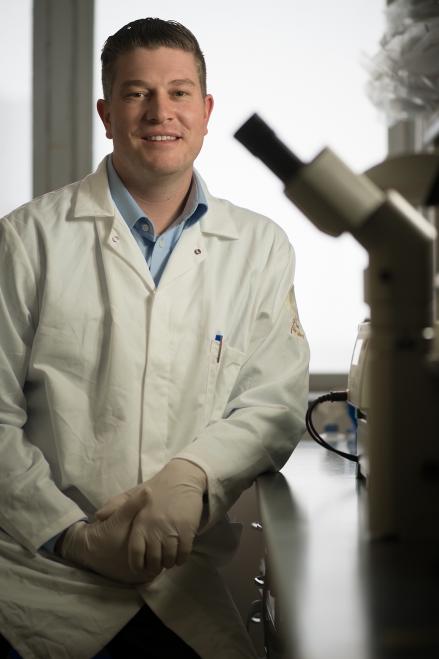
Scientists at Michigan State University have discovered a new kind of stem cell, one that could lead to advances in regenerative medicine as well as offer new ways to study birth defects and other reproductive problems.
In the current issue of the journal Stem Cell Reports, Tony Parenti, lead author and MSU cell and molecular biology graduate student, unearthed the new cells – induced XEN cells, or iXEN – in a cellular trash pile, of sorts.
“Other scientists may have seen these cells before, but they were considered to be defective, or cancer-like,” said Parenti, who works in the lab of Amy Ralston, MSU biochemist, cell and molecular biologist and co-author of the study. “Rather than ignore these cells that have been mislabeled as waste byproducts, we found gold in the garbage.”
A great deal of stem cell research focuses on new ways to make and use pluripotent stem cells. Pluripotent stem cells can be created by reactivating embryonic genes to “reprogram” mature adult cells. Reprogramming mature cells into induced pluripotent stem cells, or iPS cells, allows them to become malleable building blocks that can morph into any cell in the body.
For example, if a patient has a defective liver, healthy cells could be taken from the patient, reprogrammed into iPS cells, which could then be used to help regenerate the person’s failing organ. Taking cells from the same patient may greatly reduce the chance of the body rejecting the new treatment, Parenti said.
Prior to the discovery of reprogramming, scientists developed pluripotent stem cells from embryos. However, the embryo produces not only pluripotent stem cells, but also XEN cells, a stem cell type with unique properties. While pluripotent stem cells produce cells in the body, XEN cells produce extraembryonic tissues that play an essential but indirect role in fetal development.
Parenti and his team speculated that if the embryo produces both pluripotent and XEN cells, this might also occur during reprogramming.
The eureka moment came when Parenti discovered colonies of iXEN cells popping up like weeds in his iPS cell cultures. Using mice models, the team spent six months proving that these genetic weeds are not cancer-like, as previously suspected, but in fact, a new kind of stem cell with desirable properties.
Even more surprising, the team found that by inhibiting expression of XEN genes during reprogramming, they could decrease production of iXEN cells and increase production of iPS cells.
“Nature makes stem cells perfectly, but we are still trying to improve our stem cell production,” Parenti said. “We took what we learned by studying the embryo and applied it to reprogramming, and this opened up a new way to optimize reprogramming.”
The team wouldn’t have made this breakthrough without the high level of collaboration and access to cutting-edge facilities at Michigan State, he added.
The next steps of this research will involve seeing if this process occurs in human cells. XEN cells have yet to be discovered in humans, but the possibility of their existence is a key focus of the field.
“It’s a missing tool that we don’t have yet,” Ralston said. “It’s true that XEN cells have characteristics that pluripotent stem cells do not have. Because of those traits, iXEN cells can shed light on reproductive diseases. If we can continue to unlock the secrets of iXEN cells, we may be able to improve induced pluripotent stem cell quality and lay the groundwork for future research on tissues that protect and nourish the human embryo.”
Learn more: MSU DISCOVERS A NEW KIND OF STEM CELL
The Latest on: iXEN cells
[google_news title=”” keyword=”iXEN cells” num_posts=”10″ blurb_length=”0″ show_thumb=”left”]
via Google News
The Latest on: iXEN cells
- What do epithelial cells in urine mean?on April 30, 2024 at 5:00 pm
Epithelial cells line various surfaces of the body, including the skin, blood vessels, organs, and urinary tract. A raised amount of epithelial cells in a person’s urine may indicate an ...
- Splinter Cell remake - everything we know so faron April 24, 2024 at 7:45 am
It feels like the Splinter Cell remake has been on its way for a decent few years now, which isn't helped by the fact it's been a while since we heard anything official about the game. From what ...
- Researchers crack mystery of swirling vortexes in egg cellson April 24, 2024 at 6:16 am
Scientists have long known that maturing egg cells, called oocytes, generate internal, twister-like fluid flows to transport nutrients, but how those flows arise in the first place has been a mystery.
- Tumor cells evade the immune system early on: Newly discovered mechanism could significantly improve cancer immunotherapieson April 23, 2024 at 5:00 pm
Tumors actively prevent the formation of immune responses by so-called cytotoxic T cells, which are essential in combating cancer. Researchers have now uncovered for the first time how this ...
- Researchers create artificial cells that act like living cellson April 22, 2024 at 4:59 pm
Cells and tissues are made of proteins that come together to perform tasks and make structures. Proteins are essential for forming the framework of a cell, called the cytoskeleton. Without it ...
- Researchers create artificial cells that act like living cellson April 22, 2024 at 4:59 pm
Researchers describe the steps they took to manipulate DNA and proteins -- essential building blocks of life -- to create cells that look and act like cells from the body. This accomplishment ...
- New model finds previous cell division calculations ignore drivers at the molecular scaleon April 17, 2024 at 1:08 pm
When a single bacterial cell divides into two during periods of rapid growth, it doesn't split in half once it reaches a predetermined size. Instead, data has shown, a cell will divide once it has ...
- The best cell phone plans for May 2024on April 17, 2024 at 7:39 am
Finding the absolute best cell phone plans on the market can be tricky with the dizzying amount of options currently available. TechRadar is here to help, however, with an extensively researched ...
- The Stem Cell Divideon September 14, 2023 at 5:53 am
In the beginning, one cell becomes two, and two become four. Being fruitful, they multiply into a ball of many cells, a shimmering sphere of human potential. Scientists have long dreamed of ...
- Animal and plant cellson April 19, 2023 at 5:07 am
Cells are the smallest unit of life and the building blocks for all organisms. Each component of a cell has its own function. Animal and plant cells differ and they have similarities. Nucleus ...
via Bing News











